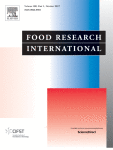Ver ítem
- xmlui.general.dspace_homeCentros Regionales y EEAsCentro Regional Buenos Aires NorteEEA San PedroArtículos científicosxmlui.ArtifactBrowser.ItemViewer.trail
- Inicio
- Centros Regionales y EEAs
- Centro Regional Buenos Aires Norte
- EEA San Pedro
- Artículos científicos
- Ver ítem
Volatile metabolite profiling reveals the changes in the volatile compounds of new spontaneously generated loquat cultivars
Resumen
In recent years, the advantageous traits of three new loquat cultivars have drawn the attention of breeders and growers. All three have spontaneously arisen from the ‘Algerie’ cultivar: the new ‘Xirlero’ cultivar is a bud mutant of ‘Algerie’, while ‘Amadeo’ and ‘Raúl’ arose as chance seedlings. Following a non-targeted approach based on HS-SPME-GC–MS, the volatile compounds profile of the fruits from the new cultivars were obtained and compared to the
[ver mas...]
In recent years, the advantageous traits of three new loquat cultivars have drawn the attention of breeders and growers. All three have spontaneously arisen from the ‘Algerie’ cultivar: the new ‘Xirlero’ cultivar is a bud mutant of ‘Algerie’, while ‘Amadeo’ and ‘Raúl’ arose as chance seedlings. Following a non-targeted approach based on HS-SPME-GC–MS, the volatile compounds profile of the fruits from the new cultivars were obtained and compared to the original ‘Algerie’ cultivar. Carboxylic acids clearly dominated the volatile profile of all the loquat cultivars, but esters, aldehydes, ketones and alcohols were also predominant compounds. Interestingly when the bud mutant event did not lead to marked changes in the volatile compounds complement, pronounced changes in the volatile composition of chance seedling-generated cultivars ‘Amadeo’ and ‘Raúl’ were observed. ‘Amadeo’ fruits showed lower levels of 2-methyl butanoic acid and much higher levels of methylhexanoate, methylbutanoate and 2-hydroxy-5-methylacetophenone. The ‘Raúl’ cultivar also had a distinctive volatile profile characterised by high levels of C6-aldehydes, (E)-2-hexanal, 2-hexenal, (Z)-3-hexenal and hexanal, and several carotenoid-derived volatiles; e.g. 2-pentene-1,4-dione 1-(1,2,2-trimethylcyclopentyl), (S)-dihydroactinidiolide, isodurene, cis-geranyl acetone, β-damascenone, β-ionone, α-ionone and 3,4-dehydro-β-ionone. These changes in volatiles were associated with a more intense flavour in cultivars ‘Amadeo’ and ‘Raúl’, according to the sensory evaluation of the flavour intensity carried out by a semi-trained panel. A metabolomic correlation network analysis provided insights as to how volatiles were regulated, and revealed that the compounds modified in ‘Amadeo’ were uncoupled from the rest of the volatilome, while the volatiles modified in ‘Raul’ changed according to specific groups. To conclude, this work provides a holistic view of how the loquat volatilome was affected, and this information was integrated with the physical-chemical-sensory attributes to understand the changes that occur in the new cultivars.
[Cerrar]

Autor
Fuente
Food research international 100 (1) : 234-243. (October 2017)
Fecha
2017-10
ISSN
0963-9969
Formato
pdf
Tipo de documento
article
Palabras Claves
Derechos de acceso
Restringido
 Excepto donde se diga explicitamente, este item se publica bajo la siguiente descripción: Creative Commons Attribution-NonCommercial-ShareAlike 2.5 Unported (CC BY-NC-SA 2.5)
Excepto donde se diga explicitamente, este item se publica bajo la siguiente descripción: Creative Commons Attribution-NonCommercial-ShareAlike 2.5 Unported (CC BY-NC-SA 2.5)

